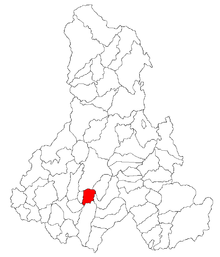Satu Mare (Harghita)
|
Satu Mare Máréfalva |
||||
|
||||
| Basic data | ||||
|---|---|---|---|---|
| State : |
|
|||
| Historical region : | Transylvania | |||
| Circle : | Harghita | |||
| Coordinates : | 46 ° 20 ' N , 25 ° 23' E | |||
| Time zone : | EET ( UTC +2) | |||
| Height : | 541 m | |||
| Area : | 39.89 km² | |||
| Residents : | 1,995 (October 20, 2011) | |||
| Population density : | 50 inhabitants per km² | |||
| Postal code : | 537026 | |||
| Telephone code : | (+40) 02 66 | |||
| License plate : | MR | |||
| Structure and administration (as of 2016) | ||||
| Community type : | local community | |||
| Structure : | Satu Mare | |||
| Mayor : | Imre Kovács ( UDMR ) | |||
| Postal address : | Str. Principală, no. 450 loc. Satu Mare, jud. Harghita, RO-537026 |
|||
| Website : | ||||
Satu Mare (outdated Marefalău ; Hungarian Máréfalva ) is a municipality in Harghita County , in the Transylvania region in Romania .
Geographical location
The municipality of Satu Mare is located in the western foothills of the Harghita Mountains - a part of the Eastern Carpathians - in the historical region of Szeklerland in the southern half of the Harghita district. On the brook Fembediu (also Brădeşti ), a left tributary of the Târnava Mare (Great Kokel) and the national road DN13A , the place Satu Mare is seven kilometers northeast of the town Odorheiu Secuiesc (Oderhellen) and about 45 kilometers west of the district capital Miercurea Ciuc (Szeklerburg) away.
The nearest train station is in Odorheiu Secuiesc on the Sighișoara – Odorheiu Secuiesc railway line .
history
The village of Satu Mare, mostly inhabited by Szeklers , was first mentioned in a document in 1566.
On the area called Vârful Cetății (Hungarian Vánnyakfok ) of the village of Satu Mare, known by the locals , remains of stone walls are noted, but these could not yet be assigned to an era. However, according to the register of historical monuments of the Ministry of Culture and National Heritage (Ministerul Culturii și Patrimoniului Național) these are assigned to the Hallstatt culture . A 36 meter square earth Burg at Cekendtetö (km 35) has been dated to the Roman period.
At the time of the Kingdom of Hungary Satu Mare belonged to the Udvarhely chair district in the Udvarhely County ( Romanian Comitatul Odorhei ), then to the historical Odorhei district and from 1950 to the present Harghita district.
Until 2004, Satu Mare was part of the Brădeşti municipality and is known for the beautiful wooden gates of several of the village's properties.
population
The population of today's Satu Mare municipality developed as follows:
| census | Ethnic composition | ||||
|---|---|---|---|---|---|
| year | population | Romanians | Hungary | German | other |
| 1850 | 937 | 55 | 864 | - | 18th |
| 1920 | 1,322 | - | 1.311 | - | 11 |
| 1992 | 2.017 | 2 | 2.014 | - | 1 |
| 2011 | 1.995 | 2 | 1,944 | - | 49 |
Since 1850 the area of Satu Mare has the highest number of inhabitants and that of the Magyars in 1992. The highest number of Romanians was in 1850, the Roma (90) in 1941. In 2002 a Romanian German was also registered in Satu Mare.
Attractions
- In Satu Mare there are eleven properties whose carved wooden gates, made between 1875 and 1906, are listed.
- The Catholic Church was built in 1771 or 1772. The sacristy altar has three crosses which are assigned to the 15th and 16th centuries.
Town twinning
Satu Mare maintain partnerships with the Hungarian towns of Magyaregregy (since 2006), with Pécsvárad (since 2008) and with Alsómocsolád (since 2014).
Web links
Individual evidence
- ↑ 2011 census in Romania ( MS Excel ; 1.3 MB).
- ↑ a b c Heinz Heltmann, Gustav Servatius (ed.): Travel Guide Siebenbürgen . Kraft, Würzburg 1993, ISBN 3-8083-2019-2 , p. 517 .
- ↑ List of historical monuments of the Romanian Ministry of Culture , updated 2015 (PDF; 12.7 MB; Romanian).
- ^ Institute Of Archeology - Satu Mare , accessed July 20, 2020 (Romanian).
- ↑ Lay pentru înființarea unor comune. (PDF; 250 kB) Accessed July 20, 2020 (English).
- ↑ Censuses 1850–2002, last updated November 2, 2008 (PDF; 1 MB; Hungarian).
- ↑ List of historical monuments of the Romanian Ministry of Culture , updated 2015 (PDF; 12.7 MB; Romanian).
- ↑ Information on the Catholic Church in Satu Mare at biserici.org, accessed on July 20, 2020 (Romanian).
- ↑ Information on town twinning on the website of Satu Mare (Romanian).


